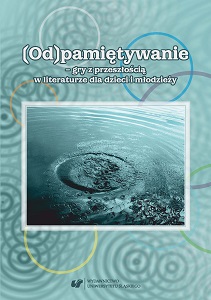Pamięć ojca i fantazmaty syna w konstrukcji obrazu Doliny w Zwierzoczłekoupiorze Tadeusza Konwickiego
The memory of the father and phantasms of his son in the construction of the image of the Valley in The Anthropos-Spectre-Beast by Tadeusz Konwicki
Author(s): Jolanta Ługowska
Subject(s): Language and Literature Studies
Published by: Wydawnictwo Uniwersytetu Śląskiego
Keywords: Memory; post-memory; dream; topos; autobiography; fairy tale; valley
Summary/Abstract: The image of the valley along with the river flowing through it, the surrounding forests and nearby railway tracks is a private topos characteristic of the works of Tadeusz Konwicki, modelled on the faithfully memorized and often remembered homeland of the writer — Kolonia Wileńska, a town near Wilno, Poland (now Vilnius, Lithuania). It appears in various novels of this author, including A Hole in the Sky (Dziura w niebie), A Chronicle of Amorous Accidents (Kronika wypadków miłosnych), and The Anthropos-spectre-beast (Zwierzoczłekoupiór). The construction of this image incorporates various literary conventions — Konwicki purposefully merges autobiography with conscious fiction and self-deprecating humour, characteristic of his works. However, in The Anthropos-spectre-beast, the valley, which is the destination of unusual journeys undertaken by the main character in time and space, in the company of a philosopher dog endowed with supernatural power, becomes primarily a magic circle, a symbol of the return to the land of childhood. Its fictional presentation is subordinated to the characteristic mechanisms of functioning of own and inherited (prosthetic) memory. The image created by Konwicki, combining the contents of visions and dreams of the son with nostalgic memories of his father, has a kind of flicker and non-finality; it is also axiologically unclear. Consequently, the valley in the novel turns out to be both a haven and a trap filled with mysterious threats; it attracts with its uniqueness but also causes anxiety of the main protagonist, who arrives here from his own world — a realistically portrayed Warsaw of the 1960s. Finally, the first-person narrative of the speaking subject puts in question the ontological status of the extraordinary valley and its inhabitants — it is challenged not only by the statements of various people from the circle of family and friends of the main protagonist but even by the protagonist himself, who approaches his own visions and dreamy images with cautious criticism.
Book: (Od)pamiętywanie – gry z przeszłością w literaturze dla dzieci i młodzieży
- Page Range: 55-68
- Page Count: 14
- Publication Year: 2018
- Language: Polish
- Content File-PDF

